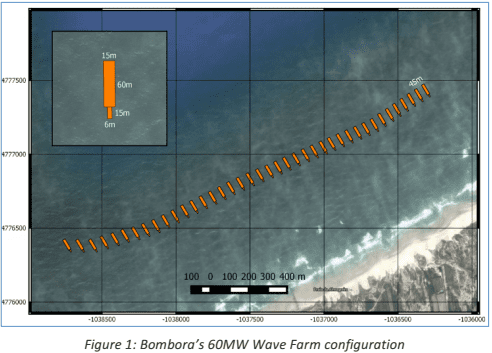Cutting edge Australian-made wave power technology could match the cost of electricity generated by commercial off-shore wind farms and solar arrays within a decade, a new report has found.
The findings were reached in a study by WA-based Bombora Wave Power, conducted ahead of its plans to deploy a 1.5MW version of its “mWave” technology in the first stage of a proposed commercial wave power farm in Portugal.

To fund Stage 1 of the project, Bombora is launching an $A8 million private capital raising, with an initial $A1million required to fund construction of the first ‘cell’ of the converter. The company says that in a grid-connected wave farm, each 1.5MW mWave unit would cost $A4.75 million to manufacture, deploy and commission.
Bombora’s unique technology is a membrane-style wave energy converter which rests on the sea bed, similar to a fully submerged reef. As ocean waves pass over it, the membrane deflects pumping air through a turbine to generate electricity.
So far, its only foray out of the lab has been for a mid-scale prototype, which was deployed in a part of Perth’s Swan River last September.
But Bombora says its recently completed Levelised Cost of Energy Study (LCOE) shows that the cost of electricity from its wave farms would be comparable to the cost of electricity from off-shore wind farms and solar arrays in Europe by 2023 (see chart below).

The study – conducted in collaboration with Worley Parsons and other industry experts – was based on the company’s proposed 60MW wave farm, which would be located 700m offshore from Peniche, Portugal.
The proposed site would have 40 1.5MW Bombora mWave converters deployed at a depth of 10 metres along its 2.5km length (see Figure 1 at top of page). Electricity generated would be delivered to the grid via subsea cables.
The study – which was supported by an ARENA grant – included investigations into a range of wave energy converter configurations, construction materials, construction process and deployment and maintenance processes. A single arm, 60 metre, two-sided, concrete structure was selected as the preferred design (see Figure 2 below).

As well as finding that Bombora wave farms would rapidly match the cost of electricity from other renewable sources, the study found that the mWaves would not be displaced during wild weather conditions, and would not impact coastal environments.
Bombora CEO Sam Leighton welcomed the findings, which follow nearly a decade of development, testing and refinement.
“Bombora’s breakthrough mWave technology will be on the world stage, competing with other renewables in the lucrative energy market within a year,” Leighton said in a statement.
“It is a unique time to invest in a game-changing product for clean energy production.“
Stage one of the planned Portugal project, which is set to go ahead in early 2017, is expected to confirm the mWave’s performance – primarily in terms of its power output – and storm survival while assessing environmental impact.
Stage 2 will involve a further three to five mWaves being deployed at the same location.









